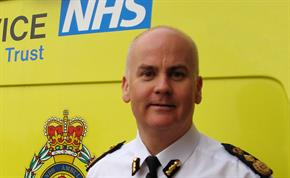
As we near the end of my first year in post I wanted to take the opportunity to review what we have achieved against the six priorities I set when I joined:
I am extremely pleased by how quickly we achieved and surpassed this target. We have now offered more than 530 contracts to student paramedics, including 60 if our existing ECAs and all of the courses for the current financial year are full. By the end of this month, 200 will be operational, which has boosted our frontline staff considerably and relieved some pressure on staff. However, very substantial increases in 999 demand this year and deteriorating hospital handover delays are continuing to exert considerable pressure on the Trust.
We set up our internal pathway for ECAs to progress to technician level, which was accredited earlier this year, and I have committed to every ECA having the opportunity to progress if they want to, and can. More than 200 ECAs have passed the pre-entry exam, 35 have completed the course and 17 have qualified as technicians. We have also set up the pathway for technicians to progress to paramedics with the University of Northampton, and 24 began their course in April and we have another 27 starting in March. I am very keen to accelerate the progression of technicians to paramedics next year.
By last February, all clinical staff who were deemed to be in roles not supporting the six priorities were returned to frontline operations. A review of our EOC procedures has been completed and improvements made, such as the implementation of regional telephony.
Based on the results of the clinical capacity review, our operational model was reviewed earlier this year and we removed a number of RRVs to crew more ambulances. We did this to reduce ambulance and back up delays, as some of our patients and RRVs were waiting hours for an ambulance to arrive. We also prioritised certain RRVs based upon activity and geography. As we recruit more frontline staff our balance of RRVs and ambulances will improve further to ensure we are providing a better service to patients, as well as support our staff.
In the first of our emergency ambulance replacement programmes this year, 147 new and replacement ambulances and 68 new Skoda Scouts were on the road by the end of May. We have now started the next programme and 53 of the 120 new ambulances are operational, all with brand new medical equipment. Once these ambulances have all been delivered by the end of March, the Trust will not have any frontline emergency vehicles more than five years old.
Through removing interim posts, agency admin and managers, voluntary redundancies, posts removed in the restructure and leavers we have not replaced, we are due to save more than ten million pounds, full year effect. Although this has been slow-going and at times a stressful process, it absolutely needed to happen; we had to redirect our funds into the recruitment of additional paramedics.
There have been lots of other noteworthy achievements this year: the new pay banding agreement I put in place for the new roles of senior paramedics and senior technicians, giving staff real career progression opportunities; we have offered contracts to72 qualified and graduate paramedics and qualified technicians and we have procured brand new trauma equipment that will improve our service to patients.
We are already planning for 2015/16 and two of the top priorities for the coming year will be another significant student paramedic recruitment drive and an ongoing programme of upskilling our existing staff.
We have seen improvements to our service, which perhaps hasn’t reflected in our performance at the rate we wanted to, but we are making progress. Last week, when compared to ambulance services nationally, we were in the middle of the pack on Red 1 performance and is improving. We were not the worst on Red 2 or R19 and again we are improving in these categories. Our call pick up time of five seconds means we are now one of the best performing ambulance service in the country.
My aspiration is for us to be one of the best performing ambulance services in the country. We are not there yet and have a way to go, but we are improving. As we recruit more paramedics and upskill our exisiting staff, our service will continue to get better.
Thank you for supporting, leading or contributing to all of these improvements to our Trust this year, and please be assured of my support now and in the future.
Published 27th November 2014